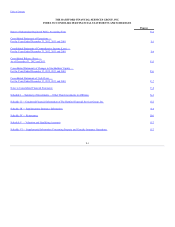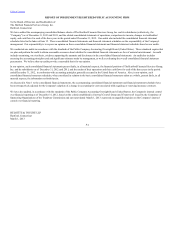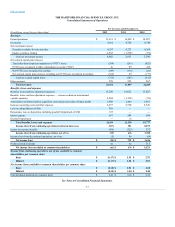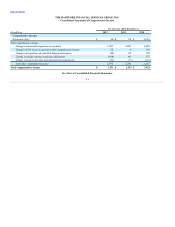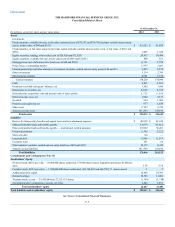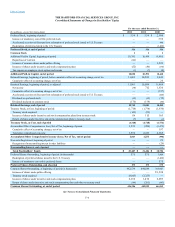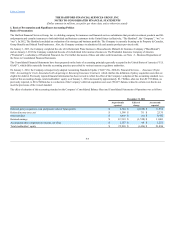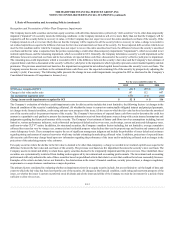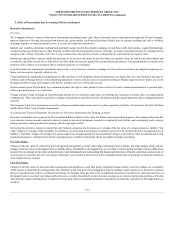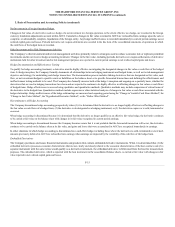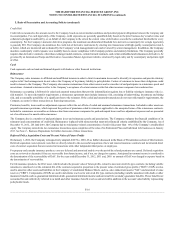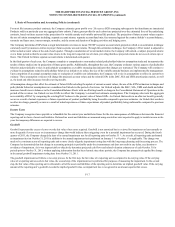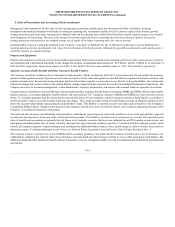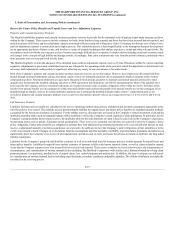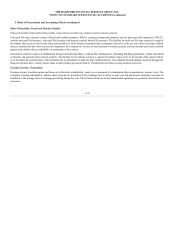The Hartford 2012 Annual Report Download - page 151
Download and view the complete annual report
Please find page 151 of the 2012 The Hartford annual report below. You can navigate through the pages in the report by either clicking on the pages listed below, or by using the keyword search tool below to find specific information within the annual report.
The preparation of financial statements, in conformity with U.S. GAAP, requires management to make estimates and assumptions that affect the reported
amounts of assets and liabilities and the disclosure of contingent assets and liabilities at the date of the financial statements and the reported amounts of
revenues and expenses during the reporting period. Actual results could differ from those estimates.
The most significant estimates include those used in determining property and casualty insurance product reserves, net of reinsurance; estimated gross profits
used in the valuation and amortization of assets and liabilities associated with variable annuity and other universal life-type contracts; evaluation of other-than-
temporary impairments on available-for-sale securities and valuation allowances on investments; living benefits required to be fair valued; goodwill
impairment; valuation of investments and derivative instruments; pension and other postretirement benefit obligations (see Note 18); valuation allowance on
deferred tax assets; and contingencies relating to corporate litigation and regulatory matters (see Note 13). The related accounting policies are summarized in the
Significant Accounting Policies section of this footnote unless indicated otherwise herein. Certain of these estimates are particularly sensitive to market
conditions, and deterioration and/or volatility in the worldwide debt or equity markets could have a material impact on the Consolidated Financial Statements.
The Company maintains a retail mutual fund operation whereby the Company provides investment management, administrative and distribution services to
The Hartford Mutual Funds, Inc. and The Hartford Mutual Funds II, Inc. (collectively, “mutual funds”). These mutual funds are registered with the
Securities and Exchange Commission (“SEC”) under the Investment Company Act of 1940. The mutual funds are owned by the shareholders of those funds
and not by the Company. As such, the mutual fund assets and liabilities and related investment returns are not reflected in the Company’s Consolidated
Financial Statements since they are not assets, liabilities and operations of the Company.
Certain reclassifications have been made to prior year financial information to conform to the current year presentation.
The Company’s significant accounting policies are as follows:
Revenue Recognition
Property and casualty insurance premiums are earned on a pro rata basis over the lives of the policies and include accruals for ultimate premium revenue
anticipated under auditable and retrospectively rated policies. Unearned premiums represent the premiums applicable to the unexpired terms of policies in
force. An estimated allowance for doubtful accounts is recorded on the basis of periodic evaluations of balances due from insureds, management’s experience
and current economic conditions. The Company charges off any balances that are determined to be uncollectible. The allowance for doubtful accounts
included in premiums receivable and agents’ balances in the Consolidated Balance Sheets was $117 and $119 as of December 31, 2012 and 2011,
respectively.
Traditional life and group disability products premiums are generally recognized as revenue when due from policyholders.
Fee income for universal life-type contracts consists of policy charges for policy administration, cost of insurance charges and surrender charges assessed
against policyholders’ account balances and are recognized in the period in which services are provided. The amounts collected from policyholders for
investment and universal life-type contracts are considered deposits and are not included in revenue. Unearned revenue reserves, representing amounts
assessed as consideration for policy origination of a universal life-type contract, are deferred and recognized in income over the period benefited, generally in
proportion to estimated gross profits.
The Company provides investment management, administrative and distribution services to mutual funds. The Company charges fees to these mutual funds
which are primarily based on the average daily net asset values of the mutual funds and recorded as fee income in the period in which the services are
provided. Commission fees are based on the sale proceeds and recognized at the time of the transaction. Transfer agent fees are assessed as a charge per
account and recognized as fee income in the period in which the services are provided.
Other revenues primarily consists of servicing revenues which are recognized as services are performed.
F-10


